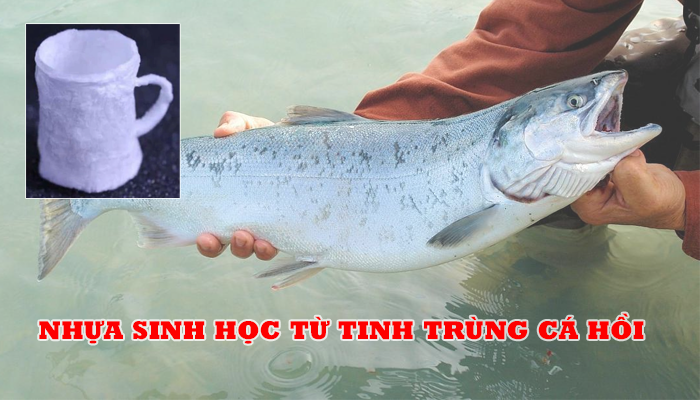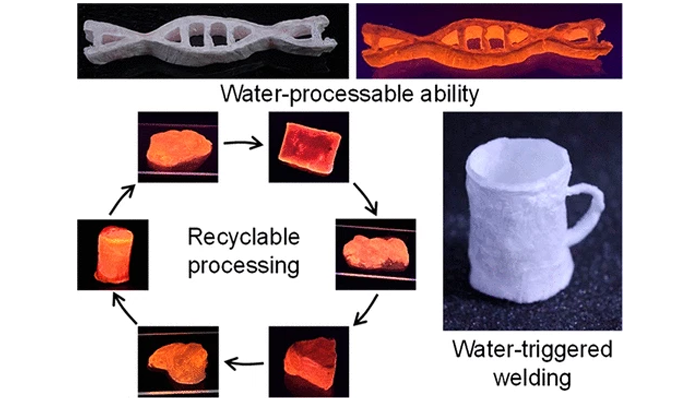
Eco-Friendly Plastic Using DNA From Salmon Sperm
In the case of a new study out of China, a way to make plastic out of salmon sperm.
GRAPHENE: THE SUPER MATERIAL FORMULATED FROM PLASTIC
COOLING PAINT
PLASTIC FOAM RECYCLING
FLEXIBLE GLASSES - INSPIRATION FROM SEASHELLS
ECO-FRIENDLY PLASTIC USING DNA FROM SALMON SPERM
Helping to keep Earth’s environment—particularly its oceans—free of gross plastic waste is going to be quite a challenge for this century. Thankfully, top minds are looking into solutions, creating, for example, incredible new machines to clean plastic waste out of rivers. Or, in the case of a new study out of China, a way to make plastic out of salmon sperm.
1. Impossible solution
To make the salmon-sperm plastic the researchers extracted two short strands of DNA from the fishes’ essence and mixed them with chemicals from vegetable oil that bound the genetic molecules together. The result of the combination was a synthetic hydrogel. That is, a 3D network of polymers that can expand and maintain a water content of up to 99%. (An image of unrelated gelatin hydrogen is in the image below.)
Once the researchers created the synthetic hydrogel—which is very much like a jelly—they then molded it into different shapes; subsequently freeze-drying the shapes to remove moisture, and, thusly, solidifying them.
The researchers tested out several use cases for their plastic consisting of salmon sperm. The team created both a miniature cup and puzzle pieces, demonstrating how their bioplastic can hold its shape. The researchers even made a DNA molecule out of their novel, environmentally friendly material.
“To the best of our knowledge, our reported DNA plastics are the most environmentally sustainable materials of any known plastics,” Dayong Yang, a researcher at Tianjin University and study lead, told the Times of UK. Indeed, the researchers say that DNA-based plastics produce 97% fewer carbon emissions than polystyrene plastics do.
DNA digesting enzymes can also break down these types of bioplastic. And people can even reform the plastic again and again simply by submerging it in water. Which sounds great because we’d rather melt our salmon-sperm mugs down in the sink than have to wash them.
>> Get advice on technical solutions during product construction <<
2. Application

After freeze-drying to remove any moisture, the hydrogel can be molded into different shapes. Scientists have already created puzzle pieces, a cup, and a plastic DNA model from the material using a process they call aqua-welding, reports Molly Taft for Gizmodo. Compared to traditional polystyrene plastics, the new bioplastic requires 97 percent fewer carbon emissions to make, reports Koh Ewe for Vice.
Oil-based plastics require tons of heat and toxic substances to manufacture and take hundreds of years to break down. While marketed as recyclable, most plastic objects end up incinerated or thrown into landfills, reports Rosie Frost for EuroNews Green.
To recycle the new bioplastic, DNA-digesting enzymes can be added to break the material down. If no enzymes are available, simply submerging the sperm-derived substance into water will turn the object back into a slop of hydrogel, Gizmodo reports. So, using the material for holding a cup of tea or holiday eggnog may not be the best idea.
However, the researchers insist it is the most sustainable material compared to other known plastics. Other biodegradable bioplastics from algae, cornstarch, sawdust leave behind a small carbon footprint over their lifetime compared to regular oil-based plastics, but creating these materials still requires energy provided by the fossil-fuel energy grid. So, there’s debate over whether these types of bioplastics are genuinely environmentally friendly, Gizmodo reports.
Bioplastic manufacturers may also be greenwashing and misrepresenting what their bioplastics contain, per Vice. After analyzing 37 products labeled as bioplastic,19 were found to be made from both petroleum and bio-based mixes, according to a study conducted by the New Zealand–based private research company GNS Science.
Because the salmon sperm bioplastic is made from DNA strands, this type of plastic can be derived from a variety of DNA sources, like plants or bacteria, per EuroNews Green.
There are about 6.3 billion tons of plastic trash on the planet, Gizmodo reports. Despite its water-resistant limitations, researchers are hopeful that this plastic made from salmon sperm could help reduce plastic waste if it enters the market.
>> Click for the best rubber chemicals on the market today <<
Contact
MEGA VIETNAM
Office address: Floor 2-A2-IA20, Nam Thang Long Urban Area, Pham Van Dong Street,
Dong Ngac Ward, Bac Tu Liem District, Hanoi City, Vietnam
Tel: (+84) 24 375 89089; Fax: (+84) 24 375 89 098
Website: megavietnam.vn
Hotline: 1800.577.728 Zalo: 0971.023.523





